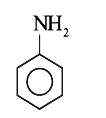Areduction −−−−−→BCHCl3/KOH−−−−−−−−→Creduction −−−−−−→N - methyl aniline then A is


CH3NH2

The correct Answer is:B
To solve the question step by step, we need to analyze the transformations described and identify the compound A.
Step 1: Identify the final product
The final product mentioned is N-methyl aniline. This indicates that we need to trace back the reactions to find the starting compound A.
Step 2: Understand the reduction process
The question states that A is reduced to give B. Since B is not specified, we can infer that B is likely a primary amine because it is a common product of the reduction of nitro compounds.
Step 3: Identify the intermediate C
Next, we see that B reacts with CHCl3 in the presence of KOH to give C. This reaction is known as the carbylamine reaction, which typically involves a primary amine reacting with chloroform and a strong base to form an isocyanide.
Step 4: Determine the structure of C
Since C is formed from a primary amine and is an isocyanide, we can deduce that C must be phenyl isocyanide (or isocyanate), which is derived from phenylamine (aniline).
Step 5: Trace back to find A
To produce phenyl isocyanide, we need to start with a primary amine. The only way to obtain a primary amine from a compound is through the reduction of a nitro group. Therefore, A must be nitrobenzene, which upon reduction gives aniline (B), and then the carbylamine reaction with aniline gives phenyl isocyanide (C).
Step 6: Confirm the final reduction
Finally, when phenyl isocyanide undergoes reduction, it yields N-methyl aniline, confirming that our initial assumption about A being nitrobenzene is correct.
Conclusion
Thus, the compound A is nitrobenzene.
---
The final product mentioned is N-methyl aniline. This indicates that we need to trace back the reactions to find the starting compound A.
The question states that A is reduced to give B. Since B is not specified, we can infer that B is likely a primary amine because it is a common product of the reduction of nitro compounds.
Next, we see that B reacts with CHCl3 in the presence of KOH to give C. This reaction is known as the carbylamine reaction, which typically involves a primary amine reacting with chloroform and a strong base to form an isocyanide.
Since C is formed from a primary amine and is an isocyanide, we can deduce that C must be phenyl isocyanide (or isocyanate), which is derived from phenylamine (aniline).
To produce phenyl isocyanide, we need to start with a primary amine. The only way to obtain a primary amine from a compound is through the reduction of a nitro group. Therefore, A must be nitrobenzene, which upon reduction gives aniline (B), and then the carbylamine reaction with aniline gives phenyl isocyanide (C).
Finally, when phenyl isocyanide undergoes reduction, it yields N-methyl aniline, confirming that our initial assumption about A being nitrobenzene is correct.
Thus, the compound A is nitrobenzene.
Topper's Solved these Questions
- AMINESBOOK - VMC MODULES ENGLISHCHAPTER - AMINESEXERCISE - EFFICIENT
49 Videos
- AMINESBOOK - VMC MODULES ENGLISHCHAPTER - AMINESEXERCISE - IMPECCABLE
48 Videos
- AMINESBOOK - VMC MODULES ENGLISHCHAPTER - AMINESEXERCISE - IN CHAPTER EXERCISE H
10 Videos
- ALDEHYDES,KETONES & CARBOXYLIC ACIDS BOOK - VMC MODULES ENGLISHCHAPTER - ALDEHYDES,KETONES & CARBOXYLIC ACIDS EXERCISE - IN-CHAPTER EXERCISE-M
10 Videos
- ATOMIC STRUCTUREBOOK - VMC MODULES ENGLISHCHAPTER - ATOMIC STRUCTUREEXERCISE - JEE Advanced (Archive )
67 Videos
Similar Questions
Knowledge Check
Identify A in the following sequence of reactions
ANH3−−→1 molBCHCI3−−−−→Alc.KOHCReduction−−−−−→(CH3)2CHNHCH3AEthyl halideBIso-propylamineCn-propyl halideDIso- propyl halideIn the given reaction sequence C6H5−CH2−NH2CHCl3/Alc.KOH−−−−−−−−−−−−−→Δ[X]H2O/NaOH−−−−−−−→[Y].
[Y] will be:AC6H5−CNBC6H5NCCC6H5−CH2−NH2DC6H5−CH2OHAn unknown alkene (A) reacts with 3 mole of H2 gas in presence of platinum catalyst to form 1-isopropyl-4-methyl cyclohexane. When unknown alkene (A) is ozonized and reduced, following product are obtained
H−O∣∣C−H H−O∣∣C−CH2−O∣∣−O∣∣C−CH3, CH3−O∣∣C−CH2−O∣∣C−H
The alkene (A) is :A B
B C
C D
D
The compound A , B and C in the reaction sequence
CH3−CH2OHPBr3−−→AAlc.KOH−−−−−→BBr2−−→C are given by the set :
View SolutionIf |→a|=3and∣∣→b∣∣=4,and|→c|=5 and each one of them is perpendicular to the sum of the other two, then find ∣∣→a+→b+→c∣∣.
View SolutionIdentify the final product ( C) formed in the following sequence of reactions
CH3CH2CH2Br alc KOH −−−−−−→(A)HBr−−→(B)aq.KOH−−−−→(c)
View SolutionICOCl2←−−−AnilineC2H5MgI−−−−−→II. Products I and II are :
View SolutionThe compound B is :
CH3CH2COOHCl3−−−−−→ red PAAlc.KOH−−−−−→B
View Solution
